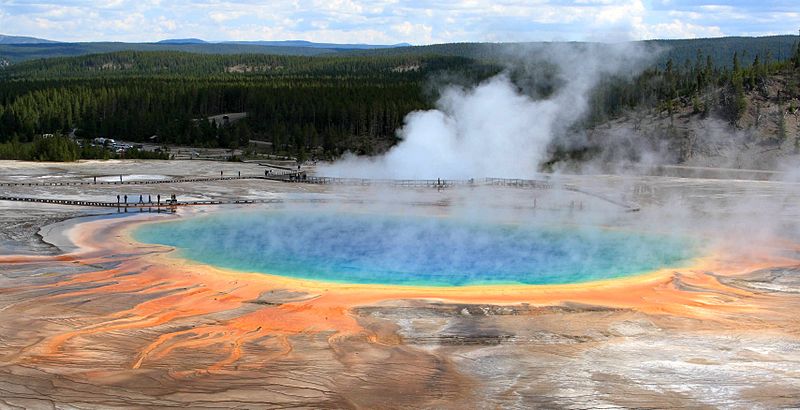If there is a place on Earth that can demonstrate to anyone how the earth’s sky is growing and transforming, it is Yellowstone National Park in the northwestern United States. Yellowstone National Park is called the living breath of the planet. The park is mainly located in the state of Wyoming and only partially occupies Montana and Idaho. It is the oldest national park in the world, founded on March 1, 1872. In 1978, it was included in the UNESCO World Heritage List. Here are the facts you need to know about this amazing natural phenomenon!

Here are the top 25 fascinating facts about Yellowstone National Park
- The name “Yellowstone” (yellow stone) comes from the gold stones found at the bottom and in the walls of the canyon through which the Yellowstone River flows.
- The total area of Yellowstone National Park is 8,983 square kilometers, which is more than 6 of the 50 states of America. It is 39 km long and 86 km wide.
- Highest and lowest points: the highest point is Eagle Peak, 3462 m. The lowest is at the northern entrance to the park, 1620 m.
- Yellowstone is the first national park in the world. The park was founded on March 1, 1872.
- Yellowstone Park has gained worldwide fame for its unusual nature. The reason is that here in the Rocky Mountains, there is a huge geological fault, leading to frequent earthquakes and advanced volcanism.
- Thanks to volcanism, all the other attractions, in addition to geysers, have appeared here, attracting tourists from all over the world. These are incredibly beautiful lava fields, deep gorges with canyons and waterfalls, amazing colorful lakes, unique flora, and fauna.
- There are more than 2000 species of plants growing here. Forests occupy 80% of the territory, the rest of the territory is steppe.
- Yellowstone National Park is not only uniquely beautiful but also extremely dangerous. It is here that the largest volcano on the planet (supervolcano) is located. The depression in which it is located is called a caldera.
- The lava is very close to the surface, but now the volcanic activity is only manifested by volcanic gases and geysers coming to the surface. If the volcano explodes, humanity is in danger of disaster.
- Yellowstone Volcano is one of the largest known volcanoes in the world and a volcanic system in North America. If it starts to erupt, it will lead to an apocalypse: the death of 10 million people at once and the gradual destruction of all life on Earth.
- In total, more than 3 thousand geysers are concentrated on the territory of the park, which is half of the total world number.
- The most famous geysers are the «Old Soldier» and the «Giant». The first emits a column of hot steam to a height of 42 meters every hour and the second every three days.
- In Yellowstone, there are between 1,000 and 3,000 earthquakes every year, but most often they are invisible to people. The last major earthquake occurred in 1959. As a result, 28 people were killed and an earthquake lake was formed.
- Of the 290 waterfalls located in the park, 15 feet (4.5 meters) high and higher, the highest and largest in terms of water consumption is the Lower Waterfall on the Yellowstone River, 94 meters high.
- Recently, there has been an increase in water temperature in the rivers and lakes of the park. In some sources, it reaches the boiling point. Geysers that were previously dormant for more than 100 years have recently been activated.
- Yellowstone is home to 67 species of mammals, 285 species of birds, 16 species of fish, 6 species of reptiles, 5 species of amphibians.
- In 2016, part of the bottom of Yellowstone Lake rose by 30 meters.
- There are 1,770 kilometers of marked trails in the park.
- The park is home not only to authentic natural wonders and magnificent scenery but also to many large mammals, including grizzly bears, coyotes, gray wolves, red foxes, wild cats, mountain lions, bobcats, beavers, otters, several species of bison and deer, Canadian snow sheep and snow goats.
- Yellowstone Park is characterized by a clear change of seasons: in winter it is cold, in spring it is pleasant, in summer it is hot, in autumn it is cool.
- In spring and autumn, the park is cool, and at night it may even snow, so when planning a trip at this time, you should take winter equipment with you.
- In summer, the park is quite warm, and the daytime temperature rises to +25 degrees. At night it is cool, and sometimes the temperature drops even below zero.
- At this time of year, it is better to come to the park. In winter, it is also very beautiful, but snowstorms often occur, and tourists will have to wait until the park staff clears the roads, and access to some attractions may be completely closed.
- Yellowstone National Park is a great example of how to reconcile wildlife with the flow of people coming here. This place is like a scene from a sci-fi movie, it simply amazes the imagination and will be remembered for many years!
- Here, among the Rocky Mountains, a person is acutely aware of how fragile, unreliable, is the solid surface of the planet is, which we used to consider reliable. Yellowstone admires itself while allowing you to get not only emotions but also to think about things deeply philosophical.

